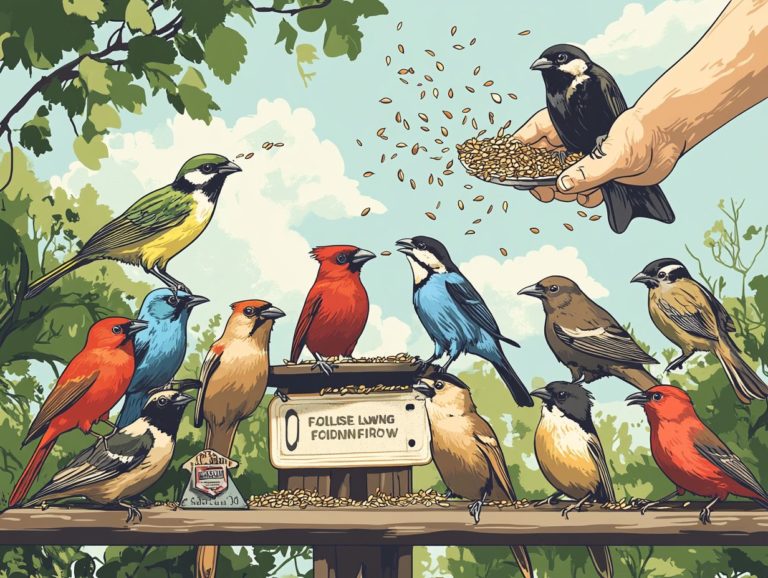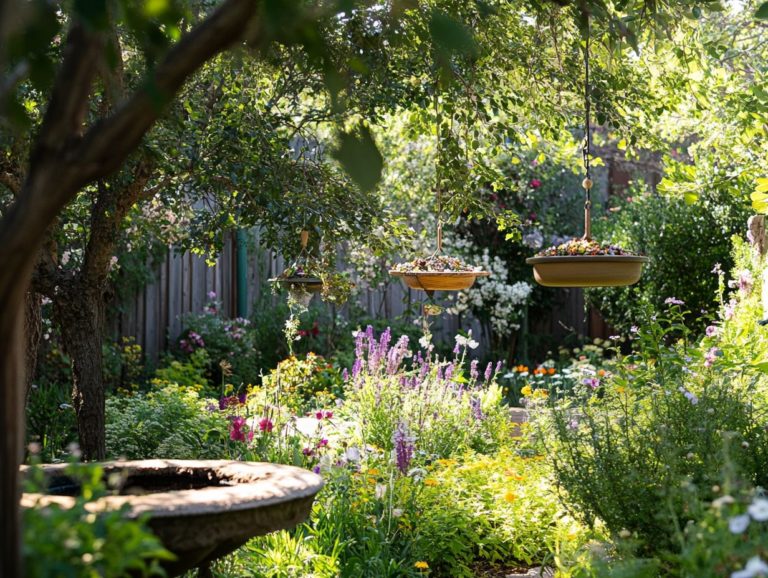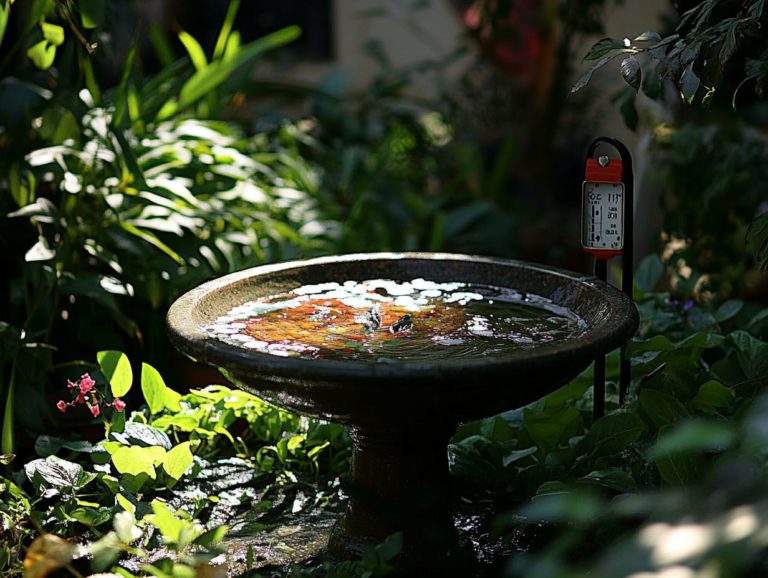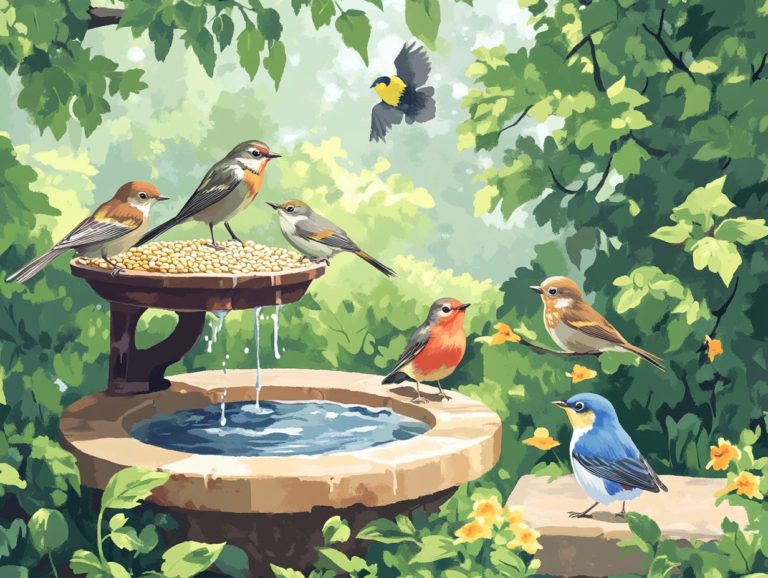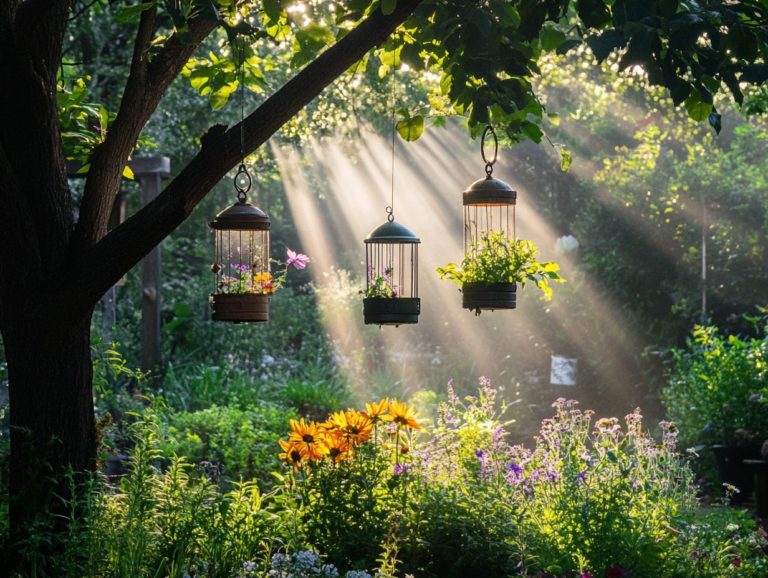Understanding the Need for Bird Baths
Bird baths transcend mere decoration in your garden; they serve a vital purpose in nurturing local wildlife.
These simple yet elegant installations provide essential hydration and bathing opportunities. They help birds flourish, particularly during dry spells.
You ll uncover the importance of water for birds, how to select the perfect bird bath for your space, and the diverse options available.
Explore tips on optimal placement, maintenance, and how to entice a variety of backyard birds into your outdoor sanctuary. By doing so, you can create a welcoming haven for our feathered friends!
Contents
- Key Takeaways:
- The Importance of Bird Baths
- Choosing the Right Bird Bath
- Types of Bird Baths
- Summary
- Placement and Maintenance of Bird Baths
- Attracting Birds to Your Bird Bath
- Frequently Asked Questions
- Why is it important to have a bird bath in my yard?
- How often should I clean my bird bath?
- What kind of bird bath is best for attracting birds?
- Can I use tap water in my bird bath?
- Are there any other benefits to having a bird bath?
Key Takeaways:

- Birds need water for drinking and bathing, making bird baths an essential addition to any backyard or garden.
- When choosing a bird bath, consider factors such as size, depth, and material to ensure it meets the needs of different bird species.
- Proper placement and maintenance of bird baths are crucial to attract birds, with the right location being a quiet and safe spot with easy access to clean water.
The Importance of Bird Baths
Bird baths are vital for creating a lively environment in your backyard. They serve as a key water source that entices various bird species, especially during migration when fresh water becomes scarce. Consider adding a bird bath heater to ensure a reliable water supply even in colder months.
Bird baths provide not just hydration but also a social gathering spot for birds. This enriches your birdwatching experience.
When you thoughtfully incorporate a well-placed bird bath into your garden, you can attract a delightful array of backyard birds. From tanagers to warblers, these visitors transform your outdoor space into a vibrant haven for feathered companions.
Why Birds Need Water
Birds require water not merely for hydration but also for bathing. Bathing is crucial for maintaining their feathers and overall health.
Access to fresh water is vital for their well-being, enabling these magnificent creatures to thrive in various environments. Regular bathing helps eliminate dirt and parasites, ensuring that their feathers remain in pristine condition.
This, in turn, enhances their flying capabilities. Fresh water sources naturally attract different bird species, fostering social interactions and creating a lively atmosphere in gardens and backyards.
Make sure to keep your bird baths in top shape to draw in more birds! By prioritizing optimal maintenance, you can craft inviting spaces that support avian visitors, significantly boosting bird activity and cultivating a more dynamic and diverse habitat.
Choosing the Right Bird Bath
Selecting the perfect bird bath is crucial for crafting an inviting oasis for birds. This process requires thoughtful consideration of various factors, including depth, location, and maintenance needs.
Ensure that you can keep water clean and suitable for our feathered friends. By paying attention to these details, you can provide a reliable water supply throughout the changing seasons.
Don’t wait! Set up your bird bath today and start enjoying the vibrant sights and sounds of nature!
Factors to Consider

When you’re selecting a bird bath, there are several key factors to consider. These will significantly enhance your chances of attracting birds and accommodating a variety of bird species.
For starters, the depth of the bath is crucial. Smaller birds favor shallower areas where they feel secure, while larger species may require a deeper bird bath.
The location is equally important; place your bird bath near natural perching spots and shelter to create a sense of safety for the birds.
Regular maintenance is essential not only does it keep the bath looking inviting, but it also helps prevent the spread of diseases among visiting birds. A well-maintained bath encourages water movement, keeping it clean and fresh.
Using the right cleaning mixture is key to maintaining water quality while ensuring the safety of your feathered visitors.
Types of Bird Baths
You ll find a range of bird baths to choose from, including ground baths and hanging baths. Each presents distinct advantages for drawing in various species of backyard birds to enhance your outdoor sanctuary.
Summary
In summary, bird baths are essential for attracting and nurturing local bird populations. By choosing the right bath and maintaining it well, you create an engaging environment that invites a variety of feathered friends into your garden. For more insights, check out why you should consider a bird bath.
Ground Baths vs. Hanging Baths
Ground baths are typically situated closer to the ground, making them a magnet for a variety of bird species, including starlings and sparrows. Hanging baths, on the other hand, are elevated, attracting more cautious birds like warblers and tanagers.
These height differences influence which birds feel at ease and affect accessibility for potential visitors. Ground baths offer easier access for smaller, ground-feeding birds, while the elevated baths entice those species that prefer to stay out of sight from ground predators.
Hanging baths can be a bit tricky when it comes to maintenance. They require careful placement to ensure stability and accessibility for both the birds and you as the caretaker. To enhance attraction, set up ground baths in open spaces with nearby shrubs for cover. Conversely, position hanging baths in sheltered areas, like under eaves or within trees, providing a sense of security for timid avian guests.
Placement and Maintenance of Bird Baths
Proper placement and maintenance of bird baths are essential for attracting birds and providing them with a dependable water source. Carefully consider the location, ensuring it s both visible and safe for your feathered friends.
Regular cleaning is crucial to keep the water fresh. Don’t forget about seasonal adjustments, such as incorporating a bird bath heater during colder months. With these simple tips, you’ll create a bird paradise that they’ll flock to!
Best Locations and Cleaning Tips
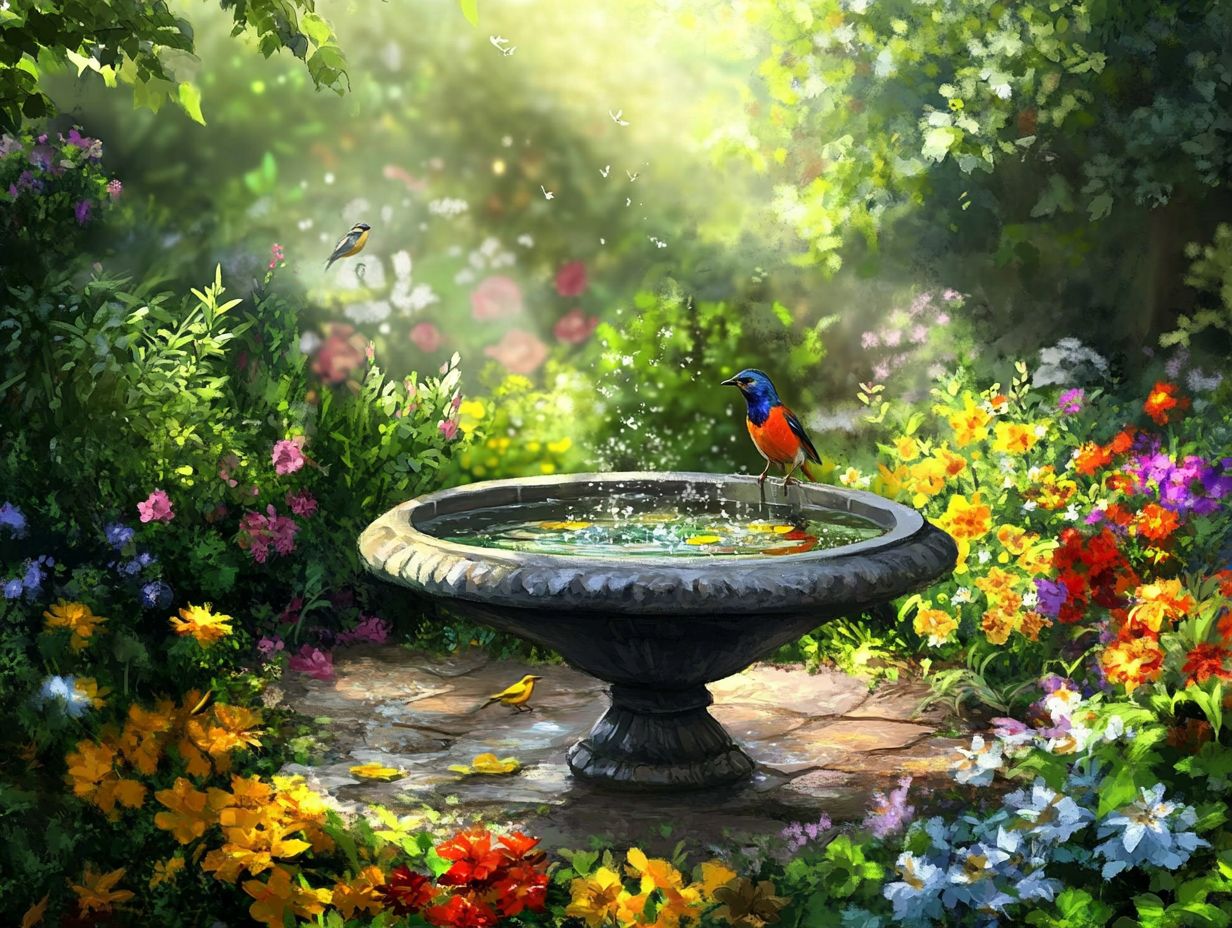
The optimal locations for bird baths are sunny spots that offer nearby perching areas and natural cover. Regular cleaning helps prevent algae growth and ensures that birds have access to a safe and inviting water source.
When selecting the perfect spot, place your bird bath near trees or shrubs that provide shelter. This allows birds to feel secure while enjoying a refreshing dip. Ensuring the bath receives ample sunlight helps keep the water warm and inviting, which is especially important during the cooler months.
Make it a habit to clean the bath regularly, ideally once a week, using a mixture of vinegar and water to effectively remove grime and prevent algae buildup. Promptly clearing away debris fosters a healthier environment, and consistently refreshing the water encourages birds to visit frequently.
Adding small stones or platforms in the bath can further aid in keeping the water clean while providing birds with safe landing spots.
Attracting Birds to Your Bird Bath
Attracting birds to your bird bath requires a keen understanding of the diverse preferences of various species. By curating an environment that caters to their hydration and feeding needs, you can transform your backyard into a true birdwatcher’s paradise.
Attracting Different Bird Species
To attract a diverse array of bird species to your bird bath, consider the specific needs and preferences of different birds, from the striking American redstart to the charming common yellowthroat and even the northern parula or yellow warbler.
Understanding what each species seeks can transform your birdwatching experience. Some birds favor shallow water for their bathing rituals, while others are drawn to deeper pools. Incorporating stones or pebbles into your bird bath can create varying depths that cater to these differing bathing styles. Offering perching spots near the water helps birds feel secure as they observe their surroundings.
Seasonal changes greatly influence bird activity. You may notice an increase in migratory species during spring, while winter brings those seeking high-energy foods to your feeders. Adjusting your birdscaping plan to include suet or specialized feeders in the colder months will ensure a vibrant, year-round avian presence in your backyard.
Frequently Asked Questions
What is a bird bath?

A bird bath is a shallow basin or pool specifically designed for birds to bathe in and drink from.
If you haven’t already, set up your own bird bath today and enjoy watching these beautiful creatures flock to your yard!
Why is it important to have a bird bath in my yard?
Bird baths give birds clean water to drink and bathe. This is vital for their survival.
How often should I clean my bird bath?
Clean your bird bath weekly to keep your feathered friends safe! This helps prevent bacteria and algae that can hurt birds.
What kind of bird bath is best for attracting birds?
Choose shallow bird baths with rough surfaces to attract a variety of beautiful birds!
Can I use tap water in my bird bath?
Treated tap water is safe for birds to drink. However, it may have chemicals that can harm their feathers. It’s best to use rainwater or add a dechlorinator to the tap water before filling the bird bath.
Are there any other benefits to having a bird bath?
Besides providing water for birds, a bird bath can attract other beneficial wildlife, like bees, butterflies, and insects, which are important for pollination.


